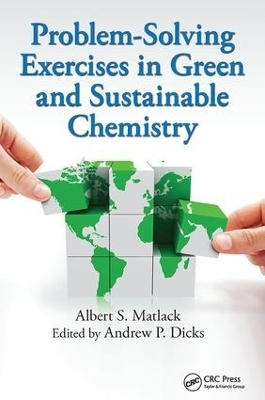
Problem-Solving Exercises in Green and Sustainable Chemistry
CRC Press (Verlag)
978-1-138-41132-6 (ISBN)
The problems described in this book are relevant and stimulating in learning and understanding the principles of green and sustainable chemistry. They address various aspects of the field, including:
Toxicity
Waste generation and disposal
Chemical accidents
Energy efficiency
New policy development
The final chapter contains proposed solutions to the presented problems and provides commentaries and references to relevant literature.
This book also prompts students to become more comfortable with the idea of multiple "correct" answers to problems. It emphasizes the reality that green chemistry is about making practical decisions and weighing multiple factors that are often conflicting, thus making it difficult or impossible to apply one perfect solution to a given situation. Problem-Solving Exercises in Green and Sustainable Chemistry prepares students to solve challenging problems, whether as green chemists, as architects designing energy-efficient buildings, or as environmentally-conscious citizens.
Albert S. Matlack began his career in chemistry with the Manhattan Project before spending 43 years at Hercules Incorporated in Wilmington, Delaware. After he was forced to retire at the age of 70, he volunteered to teach at the University of Delaware, stopping just months before his death at the age of 90 in 2013. He spent more than ten years writing the textbook Introduction to Green Chemistry and compiled the problems covered in Problem-Solving Exercises in Green and Sustainable Chemistry shortly before his death. He was passionately interested in all aspects of chemistry, and devoted his research to problems in the environment caused by chemicals. Andrew P. Dicks is a teaching faculty member at the University of Toronto. After undergraduate and graduate study in the United Kingdom, he became an organic chemistry sessional lecturer in 1999, and was hired as part of the university teaching-stream two years later. He has research interests in undergraduate laboratory instruction that involve designing novel and stimulating experiments, particularly those that showcase green chemistry principles. This work has led to over 45 peer-reviewed publications in the chemistry education literature. He has won several pedagogical awards and is the editor of the textbook Green Organic Chemistry in Lecture and Laboratory . In 2014 he was co-chair of the 23rd IUPAC International Conference on Chemistry Education. Following the passing of Albert S. Matlack, he assumed editorship of Problem-Solving Exercises in Green and Sustainable Chemistry in order to ensure the issues discussed in this book became available to the broader chemistry community.
Foreword by John C. WarnerIntroduction by Professor Hal WhiteToxicity, Accidents, and Chemical WasteGeneral BackgroundToxicity of Chemicals in the EnvironmentAccidents with ChemicalsWaste and Its MinimizationConclusionsProblemsReferencesThe Chemistry of Longer WearWhy Things Wear OutStabilizers for PolymersLubrication, Wear, and Related SubjectsInhibition of CorrosionMendingThe FutureProblemsReferencesThe Chemistry of Waste Management and RecyclingWasteRecyclingMethods and Incentives for Source ReductionOverall PictureProblemsReferencesEnergy and the EnvironmentEnergy-Related ProblemsHeating, Cooling, and Lighting BuildingsRenewable Energy for Electricity and TransportUse of Less Common Forms of Energy for Chemical ReactionsProblemsReferencesEnvironmental EconomicsIntroductionNature's ServicesEnvironment AccountingCorporationsEnvironmental Economics of IndividualsGovernment Actions Affecting Environmental EconomicsProblemsReferencesThe Greening of SocietyIntroductionIndividualsGovernmentBusinessesProblemsReferencesSolutions to In-Chapter ProblemsSolutions to Chapter 1Solutions to Chapter 2Solutions to Chapter 3Solutions to Chapter 4Solutions to Chapter 5Solutions to Chapter 6References
| Erscheinungsdatum | 05.09.2017 |
|---|---|
| Verlagsort | London |
| Sprache | englisch |
| Maße | 156 x 234 mm |
| Gewicht | 421 g |
| Themenwelt | Naturwissenschaften ► Biologie |
| Technik ► Elektrotechnik / Energietechnik | |
| Technik ► Umwelttechnik / Biotechnologie | |
| ISBN-10 | 1-138-41132-9 / 1138411329 |
| ISBN-13 | 978-1-138-41132-6 / 9781138411326 |
| Zustand | Neuware |
| Haben Sie eine Frage zum Produkt? |
aus dem Bereich


